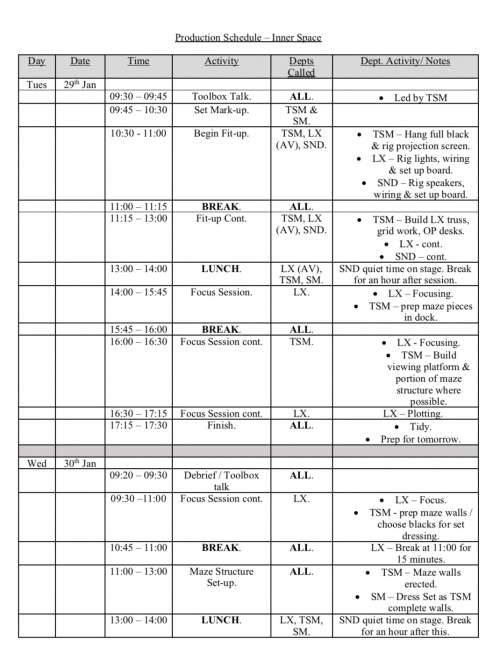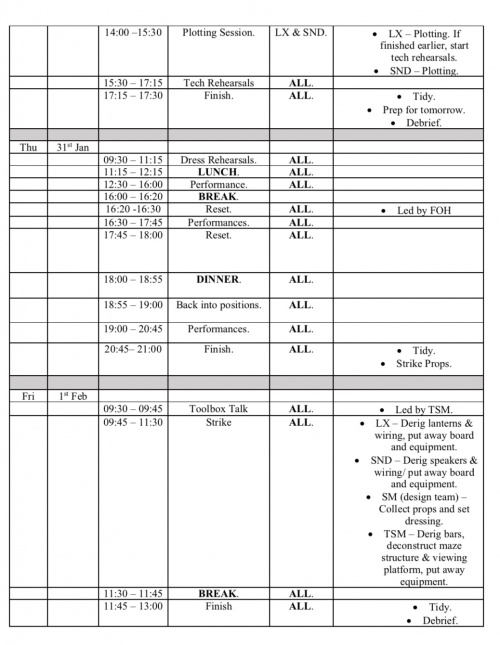Inner Space 2019: Difference between revisions
| Line 146: | Line 146: | ||
This production was an interactive experience, requiring the audience to take an active part in the performance. Due to the nature of the performance the stage management team organized and monitored the audience interaction carefully. Measures were taken to ensure the audiences safety, see risk assessments. Each player was allocated a host to guide them before the game, in between games, and after the game. They would answer any questions and provide further explanation if required. <br> | This production was an interactive experience, requiring the audience to take an active part in the performance. Due to the nature of the performance the stage management team organized and monitored the audience interaction carefully. Measures were taken to ensure the audiences safety, see risk assessments. Each player was allocated a host to guide them before the game, in between games, and after the game. They would answer any questions and provide further explanation if required. <br> | ||
The cues for the game itself were visual and given by the audience as they picked up stars and planets or were caught by ghosts. There were two players in the maze at once and no two players would navigate the maze the same way. The nature of the game, namely the unpredictability of the players, called for two people to be calling the game, one for each player. The DSM or the ASM on book and the spotter (the second person calling the game) were situated on either flyfloor allowing them a full view of the maze. <br> | The cues for the game itself were visual and given by the audience as they picked up stars and planets or were caught by ghosts. There were two players in the maze at once and no two players would navigate the maze the same way. The nature of the game, namely the unpredictability of the players, called for two people to be calling the game, one for each player. The DSM or the ASM on book and the spotter (the second person calling the game) were situated on either flyfloor allowing them a full view of the maze. The prompt book was created by DSM [[Nina Madriz]]. <br> | ||
During the performance stage manager [[Lea Meloee]] provided a point of contact for all crew involved in the running of the performance, coordinating and ensuring smooth transitions as there were crew situated in R1, oustide R1, in both flyfloors and in the wings of stage right and stage left. <br> | |||
'''Risk Assessments:''' [[File:SM_RA_InnerSpaceRace.xlsx]] <br> | '''Risk Assessments:''' [[File:SM_RA_InnerSpaceRace.xlsx]] <br> | ||
Revision as of 11:53, 18 February 2019
| Inner Space Race | ||||||||||||||||||||||||||||||||||||||||||||||||||||||||||||||||||||||||||||||||||
|---|---|---|---|---|---|---|---|---|---|---|---|---|---|---|---|---|---|---|---|---|---|---|---|---|---|---|---|---|---|---|---|---|---|---|---|---|---|---|---|---|---|---|---|---|---|---|---|---|---|---|---|---|---|---|---|---|---|---|---|---|---|---|---|---|---|---|---|---|---|---|---|---|---|---|---|---|---|---|---|---|---|---|

| ||||||||||||||||||||||||||||||||||||||||||||||||||||||||||||||||||||||||||||||||||
Logo by Darren Wilson
| ||||||||||||||||||||||||||||||||||||||||||||||||||||||||||||||||||||||||||||||||||
About
Design
Production Management
The Production Management team consisted of Production Manager, Ewan Sullivan, and Deputy Production Manager, Hannah Henderson.
Production Management was in charge of inter-departmental health and communication, establishing and leading meetings, creating team positions, enforcing correct codes of practice and deadlines, scheduling, budgetary decision making, and staff communication.
Schedule
Technical Stage Management
Stage Management
The Stage Management team consisted of Stage Manager Lea Meloee, Deputy Stage Manager Nina Madriz and Assistant Stage Managers on Book Zeni Bollok, Julia Daniczek and Rhiannon Mitchell.
The main responsibility of the stage management team was to enforce a smooth execution and running of the performance. For this particular production that meant paying extra attention to audience interaction and the calling of the performance.
This production was an interactive experience, requiring the audience to take an active part in the performance. Due to the nature of the performance the stage management team organized and monitored the audience interaction carefully. Measures were taken to ensure the audiences safety, see risk assessments. Each player was allocated a host to guide them before the game, in between games, and after the game. They would answer any questions and provide further explanation if required.
The cues for the game itself were visual and given by the audience as they picked up stars and planets or were caught by ghosts. There were two players in the maze at once and no two players would navigate the maze the same way. The nature of the game, namely the unpredictability of the players, called for two people to be calling the game, one for each player. The DSM or the ASM on book and the spotter (the second person calling the game) were situated on either flyfloor allowing them a full view of the maze. The prompt book was created by DSM Nina Madriz.
During the performance stage manager Lea Meloee provided a point of contact for all crew involved in the running of the performance, coordinating and ensuring smooth transitions as there were crew situated in R1, oustide R1, in both flyfloors and in the wings of stage right and stage left.
Risk Assessments: File:SM RA InnerSpaceRace.xlsx
Extended SM-team rotations: File:Extended SM-team InnerSpaceRace.xlsx
Performance schedule: File:Performance schedule InnerSpaceRace.pdf

